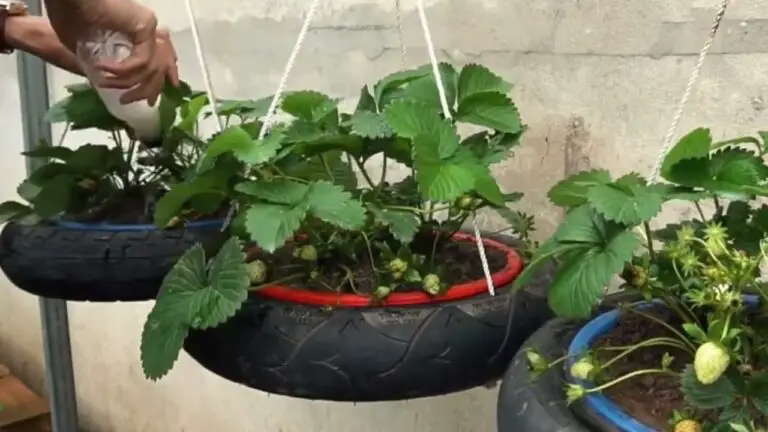36 Different Types Of Orange Flowers (A-Z)
Orange flowers can instantly brighten up a garden, indoor spaces, and vases with their vibrant hues. Contrary to the common perception that orange flowers are exclusive to summer, many species actually bloom throughout fall and even early winter. If you’re planning to adorn your yard or interior with these radiant blooms, it’s essential to know about the various types of orange flowers. Orange flowers carry distinct meanings and symbolism, making them a thoughtful addition to any setting.
From Aloe Vera to Zinnia, this article will guide you through the different varieties of orange flowers that thrive in different seasons, each with its unique characteristics.
Orange flowers meaning and symbolism
In the realm of flower symbolism, distinct colors convey unique meanings. According to international florists from myglobalflowers.com, orange blooms hold specific significance. Typically, as orange is often associated with positivity, orange flowers embody happiness, enthusiasm, and a lively demeanor. Beyond this general connotation, they also signify courage, excitement, boldness, passion, and exuberance, reflecting the vibrant energy of the color itself.
Types of orange flowers
While it’s common to associate certain flowers with specific colors, there are many varieties that offer a delightful surprise – and in this case, that surprise is the vibrant hue of orange. From unexpected twists on familiar favorites to lesser-known blooms, discover the fascinating array of orange flowers that will brighten up your day and challenge your perceptions about what flowers can look like.
Aloe Vera
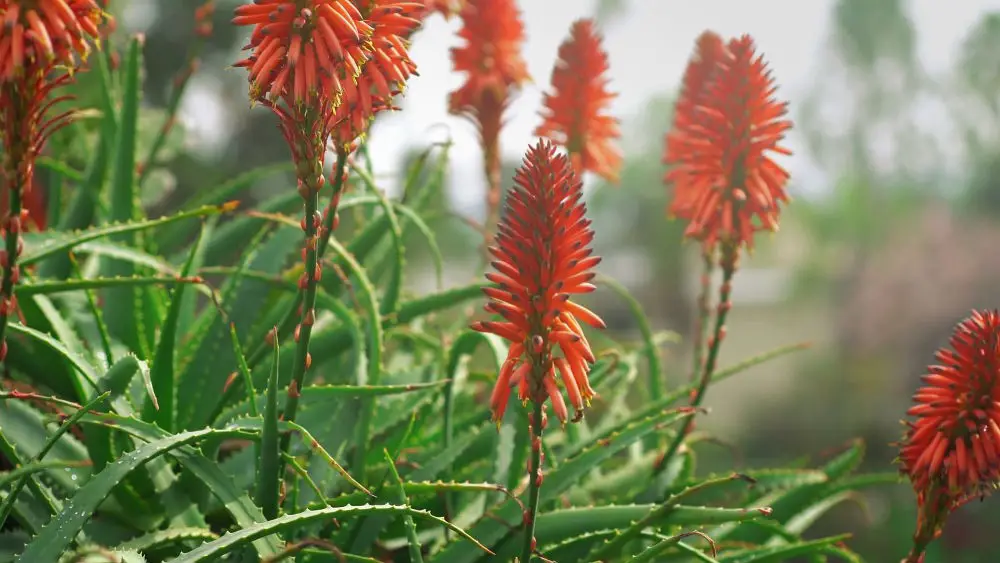
Aloe barbadensis, also known as mountain aloe or orange aloe vera, is a perennial succulent that thrives with minimal care. This easy-to-grow plant can reach impressive heights of up to 10 feet tall and forms a striking rosette at its base, where vibrant orange flowers bloom in the spring. The stems of this majestic plant are characterized by their blue-green to silver-gray hue, providing a stunning visual contrast with the bright orange blooms.
Bird of Paradise

The Paradisaeidae family boasts a distinct member in this perennial flower, characterized by its striking fan-like foliage and vibrant orange, yellow, and red blooms that arrange themselves like a crane’s head. Its natural habitat is South Africa, where it thrives under full sun or up to 10 degrees of tolerance. Notably, it can also be cultivated as an indoor plant. The flower holds significant symbolism, serving as the official emblem for nine-year anniversaries and representing faithfulness.
In terms of care, this beauty requires well-drained soil with a pH range of 6-6.5 and moderate watering. It is also known to have medicinal properties, effective in treating swollen glands.
Begonia

Begonia obliqua, a perennial plant, boasts the scientific name Begonia obliqua and belongs to the Cucurbitales order. It requires full sun or partial shade to thrive, with regular watering schedules to keep the soil consistently moist. This tropical species can tolerate hardiness zones 10 to 12, making it suitable for warm climates. The ideal soil conditions are characterized by a pH range of 5.5-6.2 and a well-drained, moist environment.
Notably, this plant has been used in traditional medicine to alleviate headaches, treat conjunctivitis, and even manage peptic ulcers. As an ornamental flower, Begonia obliqua is prized for its showy blooms, often featuring large, double petals in vibrant hues like orange, red, yellow, and pink. While it can’t withstand windy conditions, some popular cultivars include Non-stop Orange, Encanto Orange, and Picotee Sunburst.
Buttercup
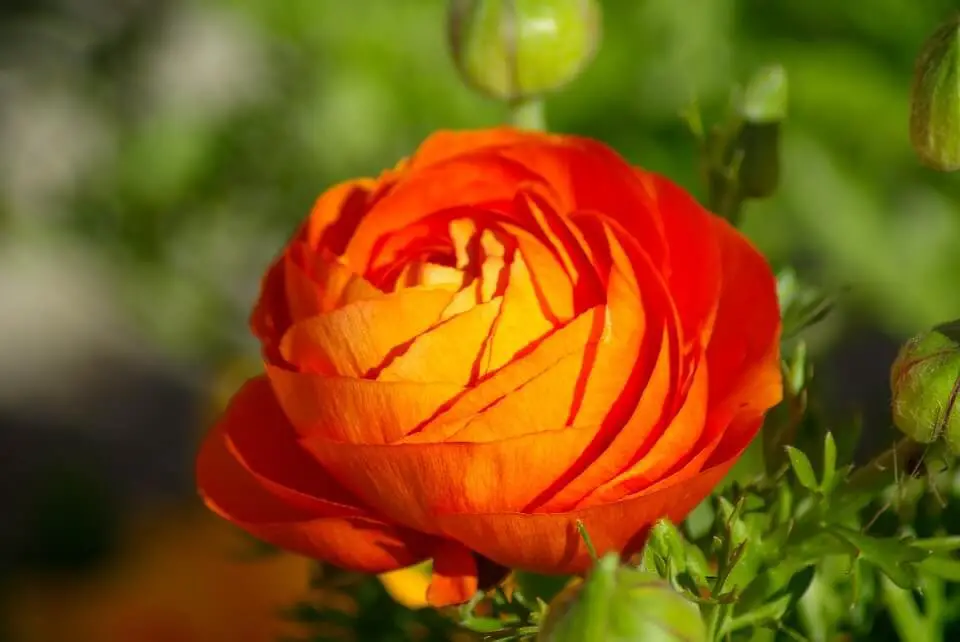
The Ranunculus family, comprising over 500 species, boasts one of its most iconic members in the buttercup plant. Characterized by its rose-shaped, silky-textured blooms in shades of deep orange, yellow, and white, this perennial beauty is renowned for its versatility in stem cut arrangements and borders. Its showy flowers bloom throughout the spring season, painting a vibrant picture with each new day.
Two of its most celebrated cultivars are Tecolote Orange and Elegance Orange, which have garnered widespread recognition for their striking hues and delicate textures. Interestingly, this versatile flower has been found to possess medicinal properties, including relief from arthritis, nerve pain, blisters, skin problems, and bronchitis, making it a valuable asset in the world of herbal remedies.
Coneflower (Orange)
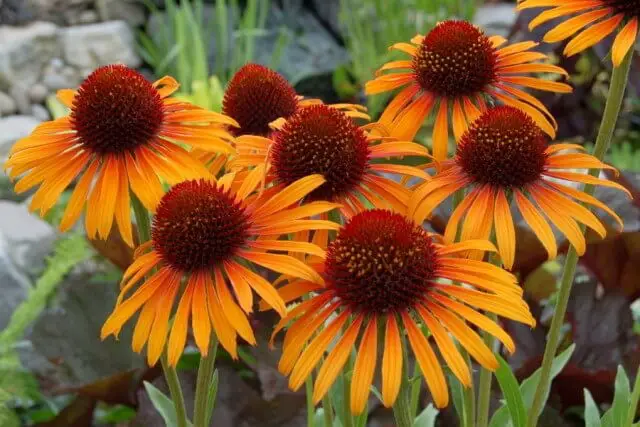
Rudbeckia fulgida, also affectionately referred to as the ‘sombrero’, boasts an impressive array of characteristics that have earned it a special place among garden enthusiasts. This perennial beauty thrives in full sun and requires low maintenance watering of just one inch per week. Its hardiness zones range from 3 to 9, making it a versatile addition to many landscapes. The plant’s well-drained soil needs are easily met, and its impressive blooms appear from early to mid-summer.
What sets Rudbeckia fulgida apart, however, is its exceptional bloom time, which stretches from spring to summer, and the abundance of bright orange flowers featuring striking black-orange center cones. These unique features have made it a favorite among birds, who delight in feeding on the seeds hidden within the cone.
Butterfly weed

The Asclepias tuberosa, also referred to as the Butterfly Milkweed or Chigger flower, is a perennial belonging to the Apocynaceae family. This low-maintenance plant thrives in full sun and requires minimal watering. Its hardiness spans zones 4-9, making it an ideal choice for many gardeners. The soil preferences are well-drained with a pH range of 6-7. In terms of medicinal uses, the Asclepias tuberosa has been known to provide relief from headaches, stomach issues, and flatulence.
Characterized by its clusters of tiny, vibrant orange flowers that bloom in the spring and are supported by sturdy stems adorned with long, pointed leaves. This plant is ideal for creating a border or as a standalone feature in any garden. Its laid-back nature makes it a great addition to any landscape.
Bulbine

The Butterfly Milkweed (Asclepias tuberosa) is a stunning perennial plant that thrives in well-drained soil with a slightly acidic pH, ranging from 6.1 to 7.8. This beauty requires partial to full sun and occasional watering, making it an ideal addition to any garden bed or mixed-container arrangement.
Native to South America, this award-winning flower is particularly renowned in Florida for its vibrant orange or yellow blooms, characterized by recurved tips and a striking center with sprouting stamens. From spring to late summer, the Butterfly Milkweed puts on a showstopping display of star-shaped flowers that are sure to attract attention.
Cosmos

The Cosmos, with its scientific name also bearing that name, is an annual herb belonging to the Asteraceae family. To thrive, it requires full sun exposure and consistent watering, making it a high-maintenance option for some gardeners. Its hardiness zones range from 3 to 10, allowing it to grow in a variety of climates. In terms of soil preferences, it prefers well-drained conditions with a slightly alkaline pH between 6.5 and 7.
During the summer season, this Cosmos variant produces vibrant blooms that can continue into the fall if properly pruned. Its antioxidant and anti-inflammatory properties make it a valuable addition to any medicinal garden.
This award-winning cultivar is renowned for its low maintenance requirements and extended blooming period. The semi-double, bright orange petals of the Cosmic Orange and Bright Lights varieties are particularly striking, as they bloom from summer into fall.
With proper care, this Cosmos variant will produce an abundance of flowers over time.
As a popular choice among pollinators like bees, butterflies, and hummingbirds, it’s no wonder that gardeners adore this easy-to-grow herb.
Canna
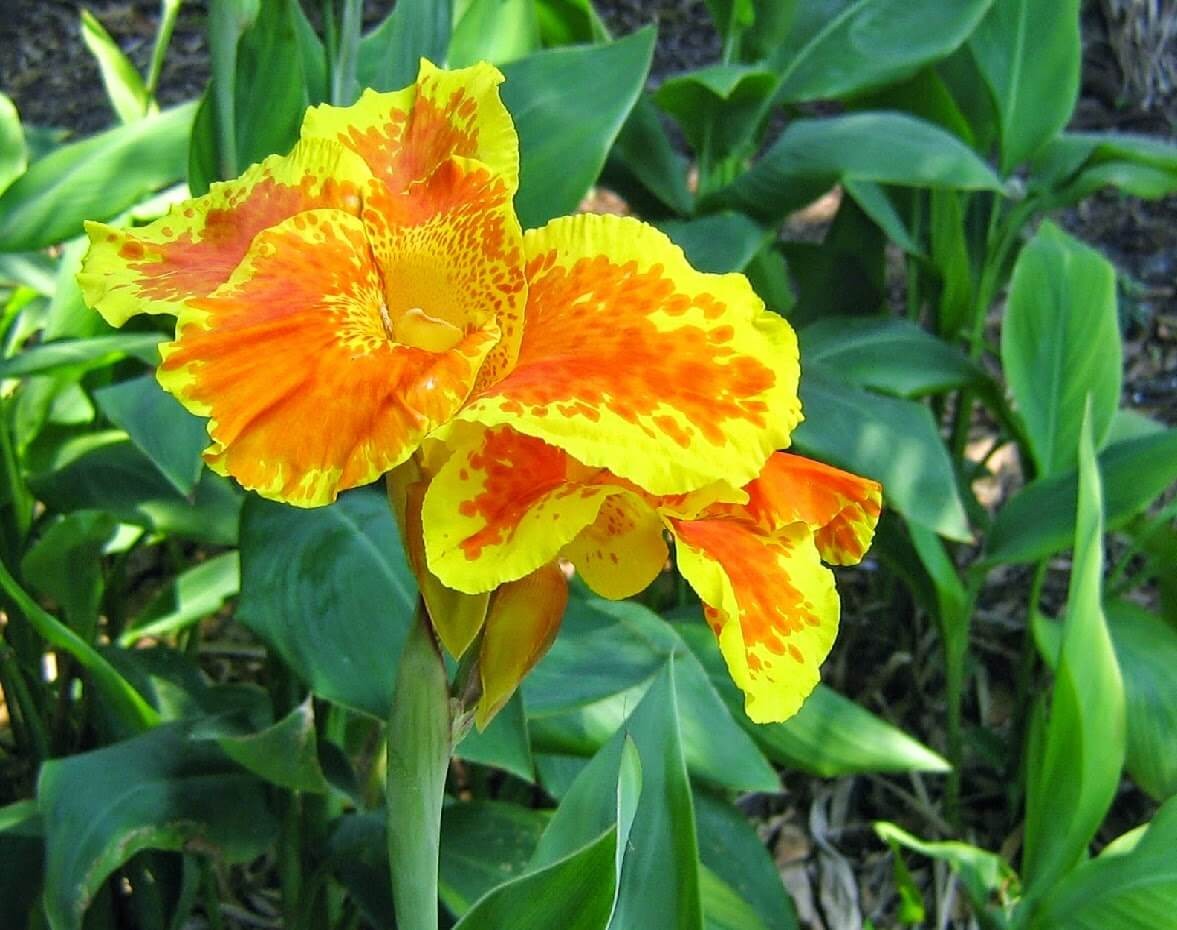
The Canna plant, classified under the scientific name Canna and belonging to the Cannaceae family, exhibits a perennial growth habit. When it comes to light requirements, this plant thrives in full sun conditions. Watering needs are substantial, with the ideal environment featuring high moisture levels. As for hardiness, Canna can tolerate temperatures within zones 8-11. In terms of soil preferences, it prefers moist and well-drained conditions, with a slightly acidic pH level of around 6.5.
During the summer and fall seasons, this plant produces blooms. Moreover, its medicinal properties have been known to help alleviate menstrual pains. Despite being often referred to as the canna lily, it does not belong to the Lilium genus, making it a distinct entity from true lilies. Visually, Canna resembles hibiscus plants, with the added feature of sturdier-looking petals boasting a vibrant orange hue on maroon stems.
Interestingly, this plant is cold-hardy and can survive winter temperatures, setting it apart from some other species.
California Poppy
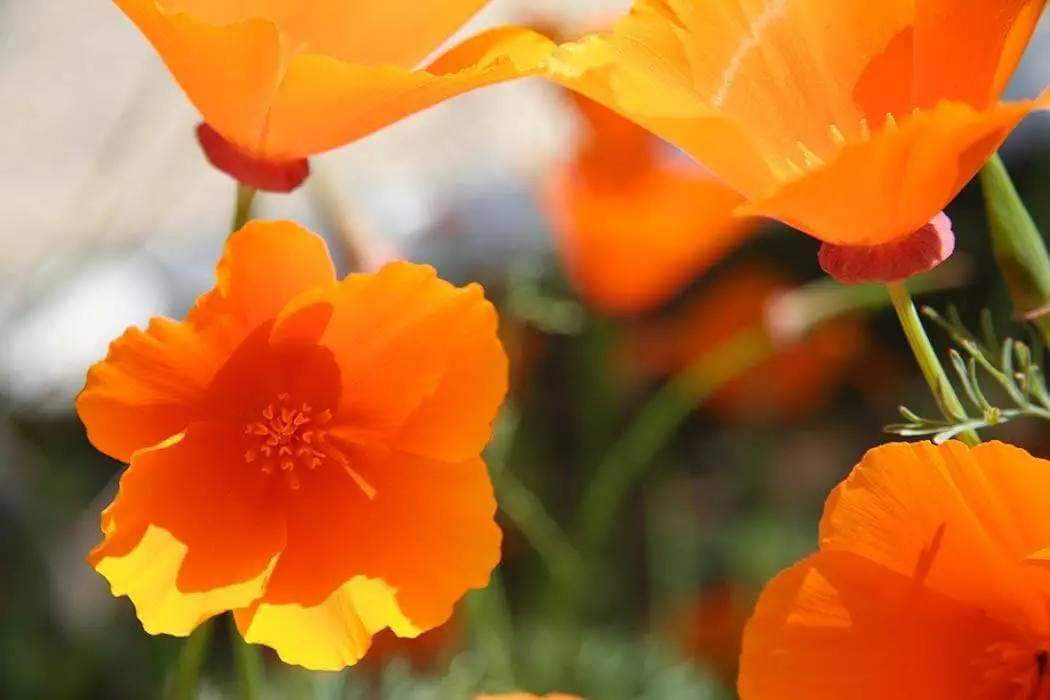
The California Poppy, scientifically known as Eschscholzia Californica, is a perennial herbaceous plant that belongs to the Papaveraceae family. This remarkable species thrives under full sun conditions and requires low watering. It’s hardy in zones 6-10, preferring well-drained soil with a pH range of 6.5-7.5. During the summer and fall seasons, it produces vibrant blooms that not only captivate the eye but also hold medicinal value.
Specifically, its extracts can be used to alleviate pain, relieve nerve pain, induce sedation, and even help with insomnia and mild anxiety. Also known as the Oriental Poppy, this plant is distinguished by its delicate, crepe-paper-like flowers that face upwards in a bright orange hue. While its appearance may suggest fragility, it surprisingly boasts a sturdy texture. Other notable varieties of orange poppies include Fireball, Prince of Orange, and Champagne Bubbles Orange.
Cymbidium Orchid

The Cymbidium, also known as the boat orchid, boasts impressive hardiness, thriving in zones 5-10. This resilient species can survive until mid-winter, offering a serene winter landscape before blooming in early spring. Its adaptability makes it an ideal choice for novice growers, as it can tolerate a wide range of climates and requires minimal maintenance.
When it comes to light, Cymbidium prefers partial shade to full sun, while its watering needs are moderate, requiring frequent hydration (twice per week). The soil should be well-drained, with a pH ranging from 5.5 to 6.5. This remarkable orchid has been linked to several medicinal benefits, including the treatment of cancer, immune system strengthening, and improved eyesight.
With its unique charm and low-maintenance requirements, Cymbidium is an excellent addition to any garden or indoor space.
Crown Imperial
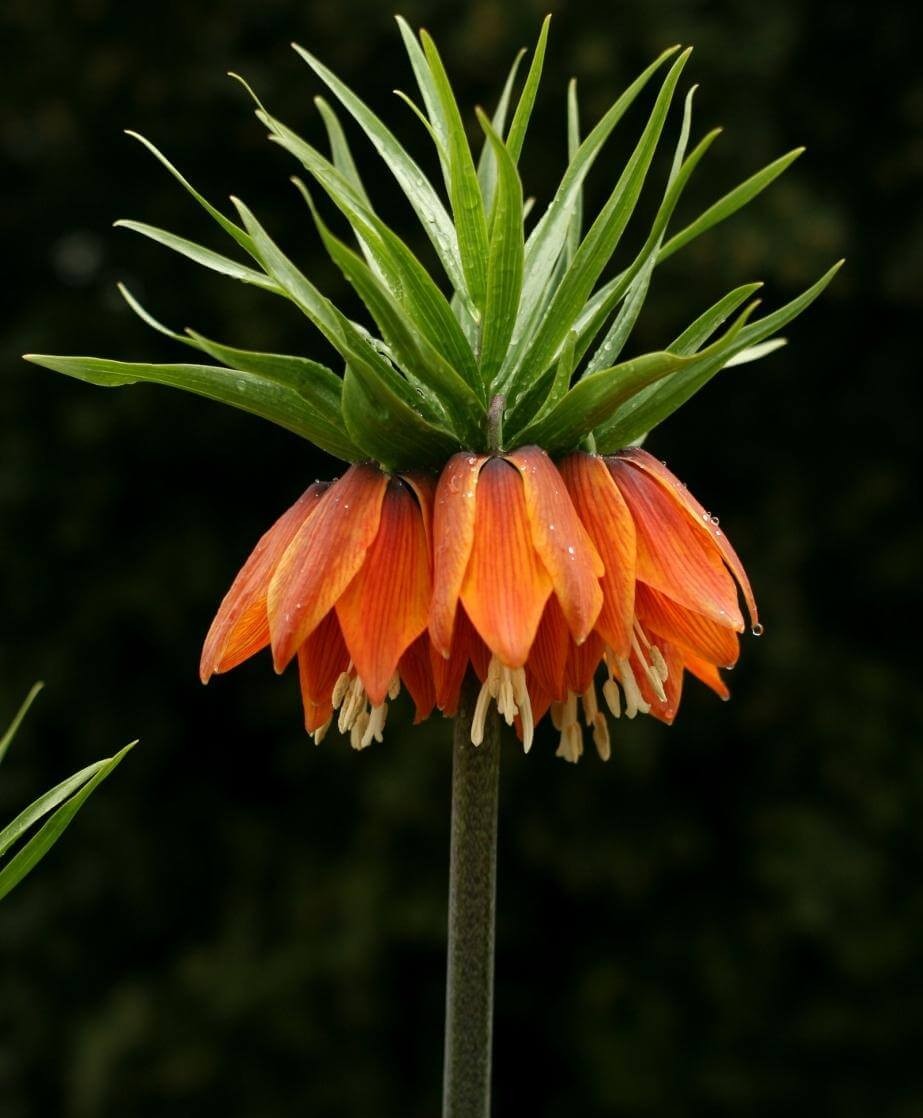
Fritillaria imperialis, a perennial beauty, boasts an unmistakable appearance that sets it apart from other spring bulbs. Its downward-facing blooms resemble a bell rather than the typical crown shape. The petals feature intricate veined markings and are adorned with white dots, making it a true showstopper. This striking flower requires partial shade to full sun, low watering, and thrives in well-drained soil with a pH range of 5-8.5.
Hardiness zones 4-10 provide the ideal conditions for this stunning perennial to flourish. When it blooms in the spring, it’s not just a visual treat – its expectorant, cardiac poison, diuretic, emollient, and resolvent properties also make it a plant with medicinal significance.
Chrysanthemum

Chrysanthemum, also affectionately known as mums, is a perennial member of the Asteraceae family. This hardy flower thrives in full sun and moderate watering conditions, making it an ideal addition to any garden. With its well-drained soil and pH level ranging from 6.5, it can be grown in zones 3-9. The blooms of Chrysanthemum typically occur during late summer into early winter, showcasing their unique spiral-like patterns.
Not only do they add a touch of autumnal charm to any landscape, but they also possess medicinal properties that have been used to treat various ailments, including chest pain (angina), high blood pressure, type 2 diabetes, fever, cold, headache, dizziness, and swelling. Furthermore, Chrysanthemum has natural insect repellent qualities, successfully warding off bugs, mosquitoes, and other unwanted insects.
The popular orange cultivars, such as the Dixter Orange and Miranda Orange, are a testament to its enduring appeal. With its numerous benefits and striking appearance, it’s no wonder that Chrysanthemum remains a beloved choice among gardeners.
Carnation
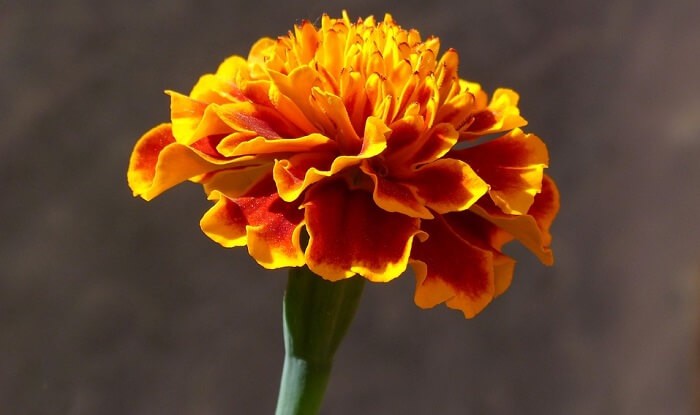
Dianthus caryophyllus, also known as Grenadine, is a perennial plant that thrives in full sun and requires moderate watering, approximately once or twice per week. Its well-drained soil should have a pH of 6.7 and fall within hardiness zones 3 to 9. In late spring, this flower blooms with large, ruffled petals featuring fringed tips that face upwards. Orange carnations are particularly prized by florists for their perpetual flowering capabilities, often paired with baby’s breath in arrangements.
Symbolically, these flowers represent motherhood, gratitude, peace, and bravery, making them a popular choice for various occasions.
Coppertips

Crocosmia, also known as Montbretia, is a perennial bulb that thrives in a variety of conditions. This summer-blooming beauty is often mistaken for a tulip due to its similar appearance, but it’s actually a member of the Iridaceae family – the same group as irises. With its deep orange pigments and sturdy stems, Crocosmia is a popular choice for flower arrangements and hummingbird gardens.
To keep this vibrant plant happy, provide it with full sun or partial shade, moderate watering (once weekly), and well-drained soil that’s pH-balanced to suit its acid, alkaline, or neutral preferences. Its blooming period typically spans from mid-summer through mid-fall, making it a delightful addition to any garden.
Daylily

The Hemerocallis, also known as Flore pleno, is a perennial that boasts striking features. Its large, vibrant orange flowers burst forth from leafless stems, earning it the nickname ‘daylily’ due to their fleeting nature. Each bloom only lasts for a day, fading at dusk before reblooming the next day – a process that takes place between early and mid-summer. This hardy plant thrives in well-drained soil with a pH range of 6-6.
5, tolerates full sun or partial shade, and requires moderate watering – especially during its initial growing season. With a hardiness zone rating of 3-10, it’s an adaptable addition to any garden. Furthermore, its medicinal properties make it a valuable asset for those seeking natural remedies. Overall, the Hemerocallis is cherished for its low-maintenance requirements and ability to thrive in a variety of conditions.
Dahlia

The Dahlia plant, scientifically known as Dahlia, is an annual that thrives under full sun. Its unique characteristics include low watering needs until establishment, followed by regular watering of 2-3 times a week. This adaptable plant can tolerate hardiness zones 3 to 10 and excels in moist, well-drained soil with a pH range of 6.5 to 7. As the seasons change, Dahlia blooms typically emerge mid-July, painting the landscape with vibrant colors.
One award-winning cultivar, in particular, stands out for its stunning peach-orange flowers that can last from summer to early winter. The long stems and showy double-petaled blooms make it a sought-after choice among florists and home enthusiasts seeking unique arrangements. Other notable orange varieties include Apricot Desire, Mel’s Orange Marmalade, and Peaches and Cream.
Gerbera Daisy

Gerbera, a perennial or annual flower, is a popular choice for its vibrant blooms that resemble true daisies. Despite being botanically distinct from the daisy family, Gerberas are often referred to as ‘true daisies’ due to their striking resemblance. This compact and versatile plant thrives in well-drained soil with a pH range of 6-7, under full sun conditions. Moderate watering is essential, ensuring the top half-inch of soil remains dry. Gerbera’s hardiness zones range from 9 to 11.
Its remarkable blooms span early spring through autumn, making it an excellent choice for vases and garden arrangements. Beyond its aesthetic appeal, Gerbera has medicinal uses, with tea preparations offering relief from coughs, bronchitis, and inflammation. The orange cultivars, such as Flori Line Maxi Orange and Garvinea Orangina, are particularly famous. Symbolizing both innocence and cheerfulness, Gerberas are a sought-after addition to any floral arrangement.
Helenium

Helenium, also known as Sneezeweed, is a perennial flower that thrives in full sun and requires moderate watering, typically early in the morning and once a week. This striking bloom can tolerate a wide range of soil conditions, with a pH level ranging from 5.5 to 7. The plant’s hardiness zones are 3-8, making it suitable for growth in many regions.
One of its most notable features is its large, showy flowers that display dainty-textured petals and a protruding center, typically blooming in shades of red-orange. While other varieties may have different colors, the Kokarde, Sahin’s, and Loysder Wieck cultivars are particularly famous for their vibrant orange hues. Not only do these blooms bring visual appeal to any garden, but they also hold medicinal properties, having been traditionally used to treat colds and headaches.
Iris
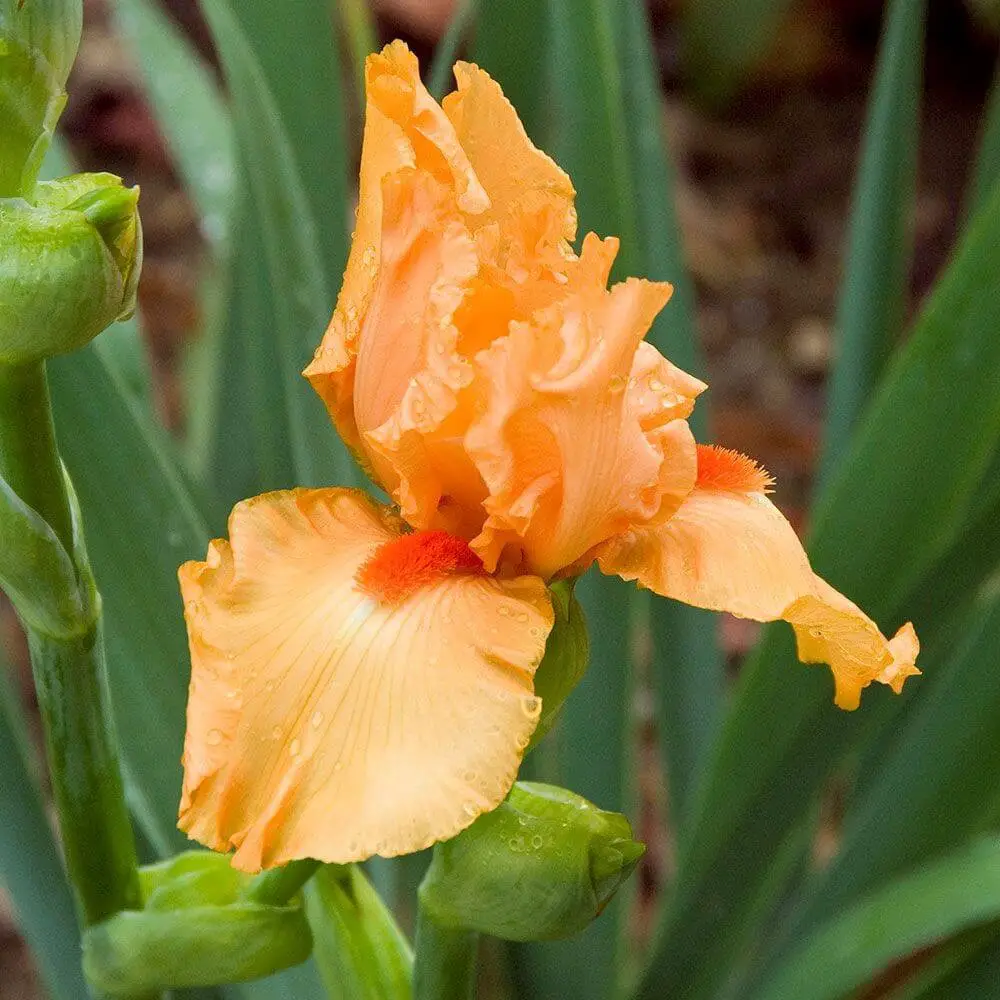
Iris croatica, also known as the maiden orange, is an award-winning perennial that boasts impressive growth rates and prolific blooming habits. Reaching a maximum height of 2ft, this plant is remarkably short in stature. Its drought-tolerant nature allows it to thrive in a wide range of soils and environments. Throughout the spring season, Iris croatica produces ruffled, faint orange flowers, creating a stunning display.
In comparison to other orange-hued iris varieties like Grand Canyon Sunset and Acapulco Gold, this cultivar stands out for its unique characteristics. Its scientific name is Iris croatica, and it falls under the Iridaceae family. To keep it happy, provide it with full sun or partial shade, moderate watering, and well-drained soil with a pH between 6.8 and 7. It’s hardy in zones 3-9, and its blooming period typically spans from early to mid-March to late June.
Lion’s Tail

Leonotis leonurus, a perennial herb that thrives under full sun, boasts an impressive ability to tolerate prolonged droughts. Its well-drained, neutral soil preferences (pH 6.6-7.5) make it an ideal candidate for cultivation in zones 8-11. As the seasons transition from late summer to fall, this striking plant erupts into a vibrant display of bright orange blooms, clustered along its slender stems and supported by sharp thorns.
Reaching heights of up to 6ft at maximum, Leonotis leonurus stands tall as a statement piece in any garden. Notably, its tiny flowers will bloom throughout the spring and into mid-fall, adding an exotic flair to the landscape. Its medicinal properties are equally impressive, having been traditionally used to treat ailments such as headaches, flu, dysentery, chest infections, epilepsy, and constipation.
Asiatic Lily

The Lilium, also known as the Fire King, boasts a striking feature in its vibrant red flowers that bloom from late spring to early summer. This perennial plant is part of the Liliaceae family and thrives under full sun or partial shade conditions. It requires moderate watering, which can be monitored using a water meter. The Lilium is hardy in zones 3-9 and flourishes in moist, well-drained soil with a pH range of 5.5 to 6.5.
As its name suggests, the Fire King has medicinal properties that have been used to treat various ailments such as spider bites, stomach disorders, coughs, tuberculosis, fevers, and childbirth pains. With its drought-tolerant nature, ease of growth, and adaptability to diverse environments, this plant is a great addition to any garden. However, it’s essential to keep in mind that the entire plant can be toxic to cats, so it’s crucial to maintain a safe distance from felines.
Other notable orange Asiatic lilies include Fire Lily, Enchantment, and African Queen.
Lantana

The Lantana, scientifically known as Lantana, is a perennial plant that belongs to the Verbenaceae family. This versatile species can thrive in various forms – it’s both a vine and a shrub. However, its most popular use is as an indoor plant in hanging baskets. The Lantana thrives in temperate climates and produces stunning tropical flowers that come in a range of vibrant hues, including orange, purple, red, and yellow.
To keep this beauty thriving, it requires full sun, low watering (once a week during its blooming season), and well-drained soil with a pH between 6.5 and 7.5. It’s hardy in zones 2-11. Interestingly, the oil extracted from the Lantana has been used in traditional medicine to treat skin itches. Its flowers bloom throughout the summer and fall months, making it a delightful addition to any indoor space.
Lily of the Incas

The Alstroemeria, commonly known as the Peruvian lily, is a half-hardy perennial that thrives in well-drained soil with a pH range of 5-6.5. These striking flowers, available in shades of pink, red, white, and salmon orange, bloom from late spring to early summer, offering a vibrant display of color. Their appearance bears a resemblance to azaleas, making them a popular choice for indoor arrangements and bouquets.
With meanings of devotion and undying love often associated with Alstroemeria, they have become a meaningful addition to various celebrations. In terms of growing conditions, these perennials require full sun or partial shade, moderate watering, and are hardy in zones 8-10.
Mexican Sunflower

The Tithonia diversifolia, an annual plant belonging to the Asteraceae family, thrives in full sun or partial shade conditions. Its low watering needs make it an excellent choice for those looking to reduce their water consumption, as it can tolerate drought. This hardy plant is suitable for USDA zones 9a and above, allowing it to flourish in warm climates. It requires well-drained soil with a pH range of 6.6-7.5 to support its growth.
One of the standout features of this plant is its unique appearance, featuring down-turned edges reminiscent of sunflowers. Its large blooms boast a striking yellow-black center and can grow up to 6ft tall. Interestingly, it produces two distinct blooming periods: one in the spring and another that lasts throughout the summer months.
Notably, Tithonia diversifolia has been used in traditional medicine to alleviate pain, treat gastrointestinal infections, skin diseases, and urinary tract infections.
Moss Rose

Portulaca grandiflora, also known as the rose of Jamaica, is a versatile and resilient plant that thrives in challenging conditions. Its botanical name, Portulacaceae, belongs to the same family as other succulent-like plants. In terms of light requirements, P. grandiflora demands full sun exposure to reach its full potential, whereas its watering needs are remarkably low due to its exceptional drought and heat tolerance.
This characteristic makes it an ideal choice for those who tend to forget to water their plants from time to time. The plant’s hardiness zones range from 10 to 11, making it a suitable option for gardeners in warm climates. In terms of soil preferences, P. grandiflora performs admirably well in dry soil conditions. Its flowering period is not limited to any particular season, as it blooms all year round.
Furthermore, the plant has been found to possess medicinal properties, effective in treating hepatitis, cirrhosis of the liver with ascites, and swelling and pain in the pharynx. In terms of its horticultural uses, P. grandiflora is commonly used as a ground cover due to its compact growth habit and as a container plant, where it can cascade down with its vibrant peach-orange blooms, creating a dramatic effect for indoor decorations.
Marigold

Tagetes, a renowned annual flower, boasts vibrant orange blooms with a ruffled, carnation-like appearance. Thriving in full sun, it produces an impressive display throughout the summer months. Notably, this plant is a natural deterrent for insects and mosquitoes. In terms of its requirements, Tagetes prefers well-drained soil with a pH between 6 and 7.5, and can tolerate partial shade if needed. Watering should be kept to a minimum, with once-weekly watering sufficient.
It’s hardiness zones range from 8 to 10, making it an ideal choice for gardeners in these regions. Interestingly, Tagetes has been found to have various medicinal uses, including skin treatments, immune-boosting formulas, and reducing eye inflammation.
New Guinea impatiens

Impatiens hawkeri, a tropical gem native to New Guinea, can add a vibrant touch to any garden. Unlike most impatiens that prefer shaded conditions, this variety is surprisingly tolerant of full sun. While it may be more challenging to grow than others, its stunning orange and purple blooms from spring through early fall are sure to impress. The Applause Orange Blaze and Celebration Orange cultivars are particularly noteworthy for their bright, showy flowers.
Nemesia (Serengeti Sunset)

The Nemesia, with its scientific name belonging to the Scrophulariaceae family, is a versatile and practical plant that can thrive in a range of environments. While it requires full sun or partial shade to flourish, regular watering will keep it happy. With a hardiness zone rating of 9-11, this plant is well-suited for warmer climates. The soil should be well-drained, which allows the roots to breathe and stay healthy.
In terms of blooming, Nemesia produces stunning flowers from April to June, making it an excellent choice for gardeners looking to add some visual interest to their outdoor spaces. Its compact size, reaching only 2ft in height, makes it an ideal option for ground cover, container or hanging basket plant, edging plant, or mixed borders. The blooms themselves are striking, with a width of 3ft and a resemblance to both lobelias and orchids.
Two popular cultivars include the Strumosa and Cerulean, offering gardeners a range of options to suit their unique styles.
Rose
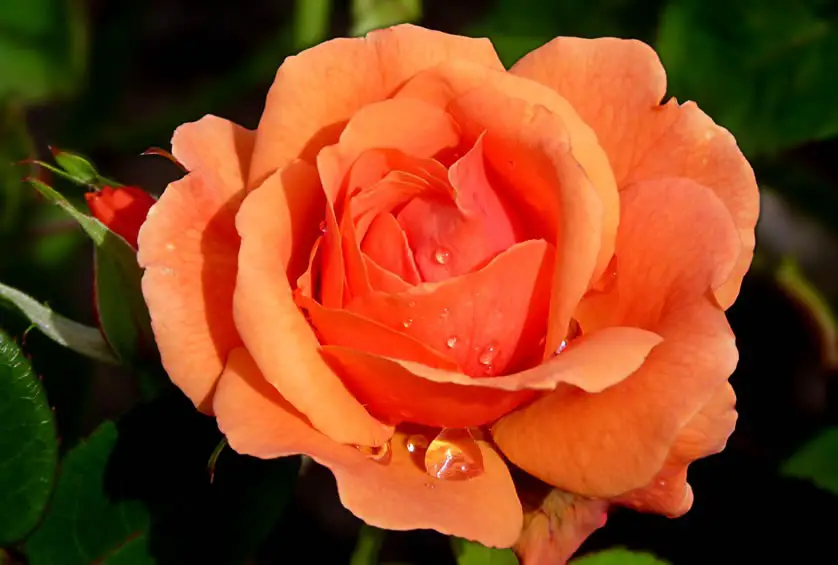
The Orange rose, scientifically known as Rosa, thrives in conditions that mimic its natural habitat. Its ideal environment includes full sun and well-drained soil with a pH range of 5.5 to 7. In terms of watering, moderate levels are sufficient – about two inches per week, spread out over the course of seven days. This type of rose is hardy in zones 4 through 9, making it suitable for cultivation in many parts of North America.
One of its defining characteristics is its ability to bloom from mid-spring to fall, providing a long season of color and interest. In addition to its striking orange hue, this variety also falls under the category of modern roses due to its all-season blooming habit. While it may not possess the same level of fragrance as some older rose varieties, the Orange rose remains a popular choice among florists thanks to its vibrant color and robust growth.
Red Hot Poker

The Kniphofia plant, also known as Torch lily, boasts an impressive range of characteristics that make it a valuable addition to any garden. With a scientific name that stands out, this plant thrives in full sun and requires low watering, making it a low-maintenance option for busy gardeners. Its hardiness zones are expansive, spanning from 5 to 9, ensuring its adaptability to various climates. The soil requirements include well-drained conditions with a pH range of 6.6 to 7.5.
As for blooms, Kniphofia produces stunning orange flowers in cone-shaped clusters that resemble flaming torches, typically appearing from early summer to early fall. In addition to its aesthetic appeal, the plant’s sword-shaped leaves stretching outward from the base create a striking visual display. Furthermore, it is attractive to wildlife and suitable for novice gardeners, making it an excellent choice for those new to gardening.
Its medicinal uses are also noteworthy, particularly in treating urinary tract, ear, and throat infections.
Strawflower

Xerochrysum bracteatum, a perennial plant, boasts a unique characteristic that sets it apart from its daisy relatives – its bushy habit. This trait is reflected in its growth to a maximum height of 3ft, where rounded, pale orange flowers with subtle tints of red and a vibrant red-orange center take center stage. While its aesthetic appeal is undeniable, the Strawflower’s allure extends beyond its visual charm.
Its low watering needs (keep the soil slightly moist) and tolerance for well-drained soil pH levels ranging from 6.6 to 7.5 make it an attractive option for gardeners. As a heat-loving plant that thrives in full sun, Xerochrysum bracteatum is suitable for hardiness zones 8-11. Its blooming period spans summer and fall, making it a delightful addition to any outdoor space.
For those seeking variety, the Strawflower’s orange hue can be complemented by other notable cultivars like Cockatoo, White Monarch, and Pink Sunrise.
Tulip
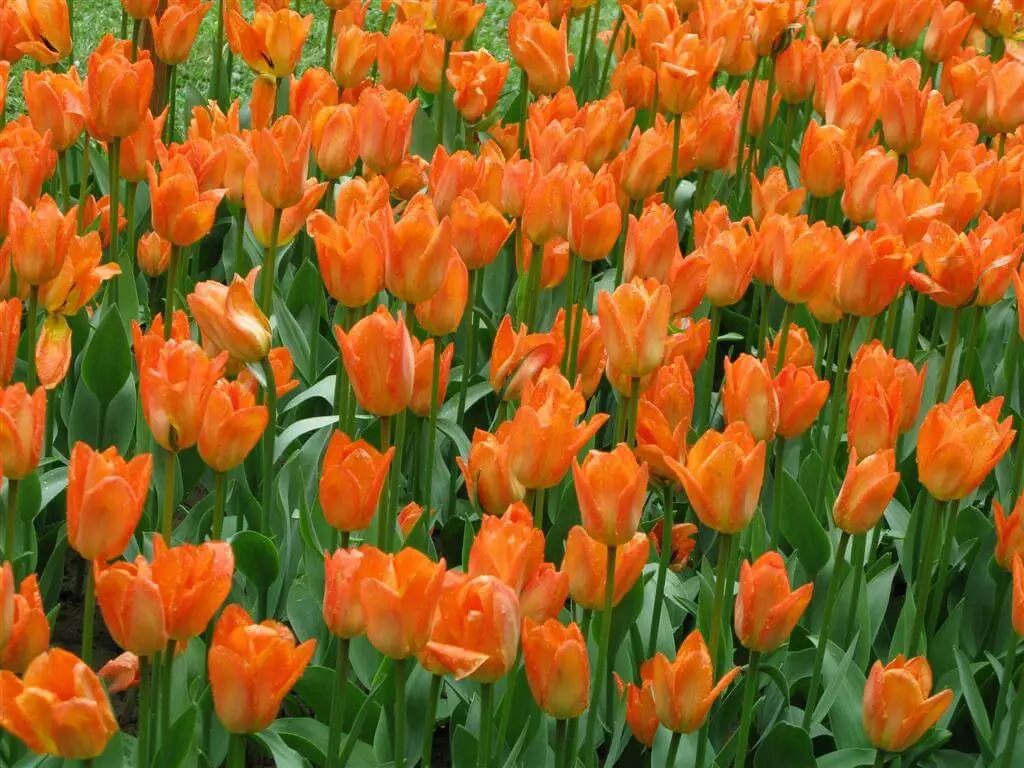
The Tulipa, a perennial or annual flower, thrives in full sun and requires low watering. Its hardiness ranges from zones 4 to 10 and does well in well-drained soil with a pH between 6.0 and 7.0. As a spring-blooming bulb, it’s no surprise that tulips are one of the most exported flowers worldwide. Among its vibrant colors, including bright orange, is where the Tulipa truly shines. The Netherlands is actually the top exporter of tulips, boasting vast gardens that bloom year-round.
Some notable varieties include Orange Princess, Calypso, and Orange Emperor – all showcasing the beauty and diversity of this iconic flower.
Tiger Lily

Lilium lancifolium is a striking perennial or annual plant that boasts an array of impressive features. Standing tall with sturdy stems, its unique flowers are characterized by their downward-facing petals adorned with mahogany brown dots and pale orange stamens. The name ‘tiger lily’ is a nod to this distinctive appearance. Beyond its visually appealing blooms, the plant thrives in full sun or partial shade, with moderate watering needs that require less than an inch of water per week.
Hardy in zones 3-9, it prefers moist soil with a pH range of 4.5-7.8. Blooming mid-to-late summer, this showy plant is not only a visual treat but also holds cultural significance, symbolizing wealth, confidence, and pride across various cultures.
Trumpet Honeysuckle (Coral honeysuckle)

The Lonicera sempervirens, also known as the Trumpet Honeysuckle, boasts a scientific name that reflects its unique characteristics. Belonging to the Caprifoliaceae family, this perennial plant thrives under full sun or partial shade conditions. In terms of watering needs, it requires about an inch of water per week during the summer months. Its hardiness zones range from 4 to 9, making it a suitable choice for gardeners in various regions. The ideal soil pH for this plant lies between 3.
7 and 6.8. As for its blooming schedule, it typically produces beautiful late-spring flowers that can last well into the summer and even fall seasons. Notably, it is often used to create stunning arbor and trellis arrangements in hummingbird gardens. Its striking salmon-orange blooms are reminiscent of other notable orange honeysuckles like Mandarin Honeysuckle and Dropmore Scarlet.
Zinnia
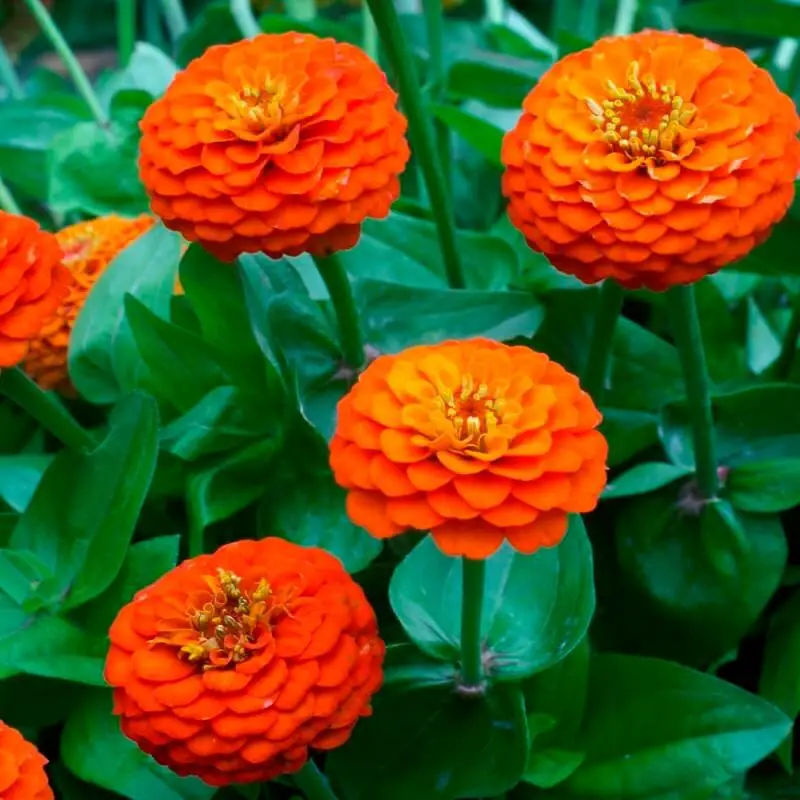
The Zinnia flower, scientifically classified as Asteraceae and belonging to the annual type, thrives in full sun with minimal watering needs – a mere 1 inch of water every five to seven days. Its hardiness zones span from 3 to 10, making it a versatile addition to any garden. Ideally, it grows well in well-drained soil with a pH range of 5.5 to 7.5.
When it blooms, the Zinnia is a sight to behold – an explosion of vibrant colors including red, pink, purple, yellow, and orange, all blooming simultaneously. Its semi-double blooms give it a unique resemblance to dahlias. One of its most notable characteristics is its extended blooming period, which spans from late spring to the onset of frost. This cold-hardy flower also boasts an impressive range of cultivars, including the famous Orange King, Zinderella Peach, and Queeny Lime Orange.
Conclusion
In wrapping up this reflection, it’s crucial to acknowledge that each type of orange flower is a distinct entity with its own story to tell. While their vibrant color may initially grab our attention, it’s essential to delve deeper and appreciate the rich history and cultural significance behind many of these flowers. By doing so, we can foster a deeper connection with the blooms that will soon take residence in our gardens.
And if you’re seeking a burst of energy and freshness for your home, look no further than these remarkable orange flowers – an excellent starting point for any flower enthusiast.
Related Posts
When it comes to flower delivery, tipping your courier is often a topic of debate. As you consider whether or not to leave a gratuity, it’s essential to understand the role these couriers play in ensuring your blooms arrive fresh and on time. Meanwhile, if you’re looking for a burst of color in your garden, partial shade gardens or containers are the perfect spot to plant some perennials with bright yellow flowers.
And for those who love low-maintenance plants, African violets make great additions to indoor spaces. If you’re looking to add some flowering flair to shady corners, astilbe is a perennial that’s sure to impress. For gardeners in colder climates, finding the right shade perennials can be a challenge, but with these top ten picks, you’ll be on your way to creating a lush and thriving shade garden.





